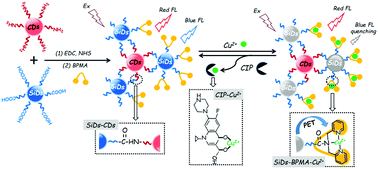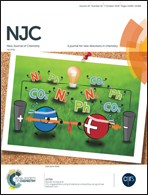Ratiometric fluorescence, solution-phase and filter-paper visualization detection of ciprofloxacin based on dual-emitting carbon dot/silicon dot hybrids
Abstract
Herein, we report a novel and facile strategy for the ratiometric fluorescence (FL), solution-phase and filter-paper visual detection of ciprofloxacin (CIP) based on dual-emitting carbon dot/silicon dot (CD/SiD) conjugates. Red-emissive CDs with surface amino-modification were combined with surface carboxyl-modified and blue-emissive SiDs via carbodiimide-activated coupling. Then, the conjugates were functionalized with bis(3-pyridylmethyl)amine (BPMA) on the SiD surface to prepare CDs/SiDs–BPMA hybrids. The coordination of Cu2+ to BPMA sites led to marked blue FL quenching of SiDs because of photo-induced electron transfer from SiDs to the BPMA–Cu2+ complex. The addition of CIP induced clear FL recovery of SiDs due to competitive coordination of Cu2+ to CIP over BPMA. The Cu2+ ions specifically reacted with BPMA and CIP on the SiD surface but hardly influenced the red FL of CDs, which thus served as a reference. The CDs/SiDs–BPMA–Cu2+ system was developed as an efficient ratiometric FL (ISiDs/ICDs) probe to determine CIP based on CIP-induced dramatic ratiometric FL turn-on responses and FL color changes from red to blue. This probe enabled naked-eye visual detection of CIP in the solution phase and on filter paper. In pharmaceutical preparations and real human fluids, this probe exhibited superior capability for CIP detection over interferents with high detection recoveries.



 Please wait while we load your content...
Please wait while we load your content...